![]()
Aroids and other genera in the Collection
Take the Tour Now?
Orchids
The
Exotic Rainforest
Plants in
the Exotic Rainforest Collection
The images on this website are copyright protected. Please contact us before any reuse.
In depth information on how to grow Philodendron species, Click this Link
Within our collection we have many species of Philodendron. If you are seeking other photos, click this link
The common name "Philodendron cordatum Hort."
is not the same plant as the species known to science as
Philodendron cordatum Kunth. "Hort." indicates the name is
a horticultural common name and is not scientific.
Click here to see
Philodendron hederaceum, P scandens, P oxycardium, P. micans.
Philodendron cordatum
Kunth
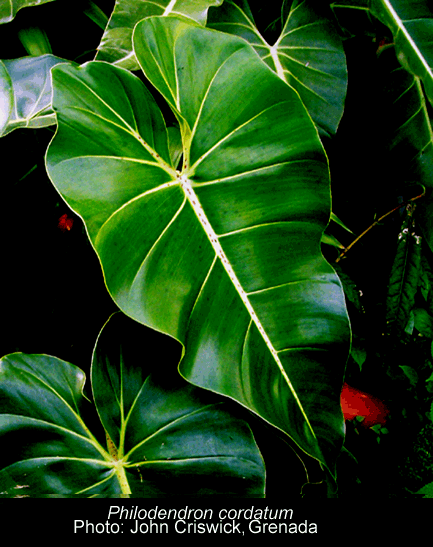
Philodendron
cordatum Kunth
Synonym: Arum cordatum
Common names:
Philodendron Angra dos
Reis,
Heart Leaf Philodendron,
Published to
science in
1856, Philodendron cordatum (cor-DAT-um) is not a synonym for either Philodendron
scandens
or
Philodendron oxycardium The species Philodendron
cordatum is not similar
to either. Despite the claims of many
websites Philodendron cordatum is not a commonly
kept house plant.
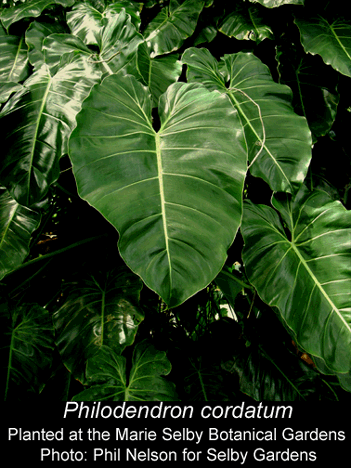 The
common name "Philodendron cordatum Hort." is used incorrectly by plant
collectors for the species known to science as Philodendron hederaceum
but is not a scientific name nor a synonym relating to that species.
Philodendron hederaceum is common to much of Mexico, all of Central America,
almost all of tropical South America as well as portions of the Caribbean but is
not related to Philodendron cordatum Kunth except by genus.
The
common name "Philodendron cordatum Hort." is used incorrectly by plant
collectors for the species known to science as Philodendron hederaceum
but is not a scientific name nor a synonym relating to that species.
Philodendron hederaceum is common to much of Mexico, all of Central America,
almost all of tropical South America as well as portions of the Caribbean but is
not related to Philodendron cordatum Kunth except by genus.
Philodendron hederaceum
is likely the most commonly grown house plant in most of the
civilized world and is one of the most variable of all
Philodendron species taking on many leaf forms, textures
and colors. Variations of Philodendron hederaceum are commonly called
the "heart leaf Philodendron". The term "heart leaf" comes from the
shape of the leaves which is known as cordate. A
cordate leaf is simply one that is shaped like a heart and the species
Philodendron cordatum Kunth also possesses a cordate leaf.
Found
in one specific region along southeastern Brazil's coast, Philodendron
cordatum is endemic or exclusively found only in the coastal regions near Rio de Janeiro and São Paulo. P.
cordatum is primarily an epiphyte (ep-a-FIT) which indicates it is a
natural tree climber but the species also grows across the
ground where it is observed growing as an
epilithic (epi-LITH-ic) vine.
My friend and
invertebrate ecologist/
taxonomist Christopher Rogers wrote,
"I have Philodendron
hederaceum in my collection and have seen both P. hederaceum and Philodendron
cordatum in Brazil. P. cordatum is far bigger than hederaceum and
the purple spotting is really lovely. I have only seen P. cordatum growing
along the ground in rocky terrain while P. hederaceum was always up in the trees
with lots of hanging vines."
Epilithic plants
grow attached to stone.
Aroid expert Leland Miyano explains about the growth habit as well as the area where Philodendron
cordatum grows in nature, "Near
the
town of
Parati and Ilha Grande in the Brazilian state of Rio de Janeiro the granite
coastlines have Philodendron cordatum as rupicolous or saxicolous creepers
growing on the enormous granite boulders that line the shores. These specimens may have
fallen from trees or started on the humus that accumulates on the boulders. They
often form a sort of border between the shoreline and the forests"
The coastal town
of Parati is west and slightly southwest of Rio de Janeiro. Rupicolous (r-PIK-lus) and saxicolous (sak-SIK-lus)
plants are species that grow either on or among stones.
Many websites including a few
associated with universities and the U.S. government indicate
Philodendron cordatum is a synonym for Philodendron
scandens subsp. oxycardium. Scientifically that is
inaccurate since neither the
published
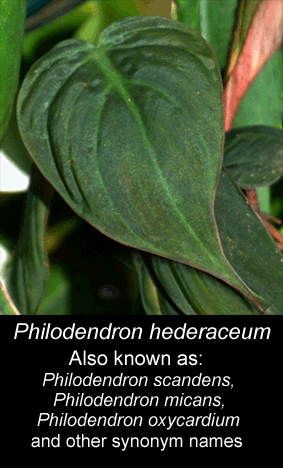 scientific description
of either of these plants nor
any recognized scientific data base indicates these species are one and the
same. In science a synonym is a species which has
been previously published and described to science but was
again published using another name. This "myth"
appears to have been advanced in horticultural circles in the past and
has persisted as "fact" with plant
collectors as well as some authoritative sources. "Philodendron
cordatum Hort." is nothing more than a common name with no scientific
significance.
scientific description
of either of these plants nor
any recognized scientific data base indicates these species are one and the
same. In science a synonym is a species which has
been previously published and described to science but was
again published using another name. This "myth"
appears to have been advanced in horticultural circles in the past and
has persisted as "fact" with plant
collectors as well as some authoritative sources. "Philodendron
cordatum Hort." is nothing more than a common name with no scientific
significance.
Philodendron scandens (scan-DENS) was published in
1853 and Philodendron oxycardium
(oxy-CAR-deum)
was published in 1857.
Both
are common house plants and each has was sunk into synonymy
in 1856 under Philodendron hederaceum
(hay-day-RA-see-oom). Philodendron hederaceum
was described and published much earlier in 1829.
The specimen of Philodendron cordatum
growing at the Marie Selby Botanical Gardens in Sarasota, FL
shown at the top right of this page was grown from seed collected from a private nursery in
Brazil during the early 1970's. The specimen was originally tagged "P. Angra dos Reis"
due to the location where it is commonly seen in nature and was
set out at the garden in 1978 where it has survived an extreme
low temperature of 4.44 C (24 F) in 1983. The leaf blades
of that specimen measure 38 to 61 cm (15 to 24 inches) in
length. Phil
Nelson's photo was provided by Harry Luther of the Marie Selby
Garden.
Once shown a photo
of a juvenile specimen in our collection Hawaiian aroid expert Leland Miyano explains
how the common name Angra dos Reis
originated, "Philodendron
'Angra dos Reis is Philodendron cordatum Kunth. Your plant is
still a juvenile, so it resembles a few things. Philodendron
cordatum is a wonderful plant and can take the cold of Sarasota
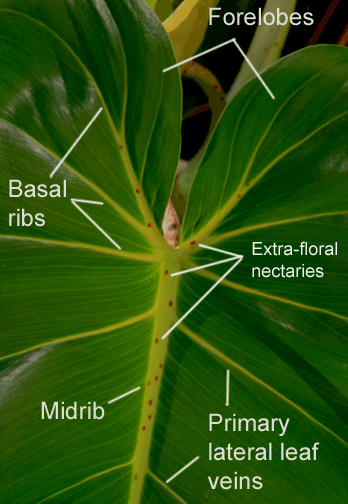 where I saw it growing happily
outdoors. I saw large groups of
these at Angra dos Reis in the state of Rio de Janeiro which is a bay town with
granite boulder coastlines. This species grows just back of the
high tide lines and into the forests."
The name Angra dos Reis means "King’s
Cove" in Portuguese and is
a city approximately 150 km
(60 miles) southwest of the city of Rio de Janeiro,
Brazil. Famous for its coastline on the Bay of Ilha
Grande with its 365 islands the name Philodendron Angra
dos Reis appears to
have been used in a seed list
from the late 60's early 70's.
where I saw it growing happily
outdoors. I saw large groups of
these at Angra dos Reis in the state of Rio de Janeiro which is a bay town with
granite boulder coastlines. This species grows just back of the
high tide lines and into the forests."
The name Angra dos Reis means "King’s
Cove" in Portuguese and is
a city approximately 150 km
(60 miles) southwest of the city of Rio de Janeiro,
Brazil. Famous for its coastline on the Bay of Ilha
Grande with its 365 islands the name Philodendron Angra
dos Reis appears to
have been used in a seed list
from the late 60's early 70's.
The leaves of Philodendron cordatum are a medium green and become deciduous. A deciduous plant is one that often looses its leaf blades during periods of dryness. The blades of P. cordatum are glossy on the blade's top known as the adaxial surface as well as subcoriaceous to moderately coriaceous in thickness. Coriaceous indicates the blades are leathery to the touch while subcoriaceous indicates they are just less than leathery. The lower or abaxial leaf surface is matte. The leaf blades may be moderately bi-colorous or two colored. The blades cordate as well as ovate (slightly oval) to broadly ovate at the apex. The base of the blade is cordate with an acute lower tip. The term acute indicates pointed while cordate indicates heart shaped. The leaf blades may grow as large as 40 to 65 cm (15.75 to 25.5 inches).
Aroids and other plant species have veins sometimes known as nerves on each leaf blade. The venation is distinct in some species but far less so obvious in others. Each vein type has a specific name for purposes of being specifically described in to science since specific characterizes are important to the determination of any species.. The most prominent veins on Philodendron cordatum are the midrib, basal ribs, and primary lateral leaf veins. The interprimary or secondary veins are less obvious as are the tertiary or minor veins. There should be 5 to 7 primary lateral veins on each side of the midrib at the center of each leaf.
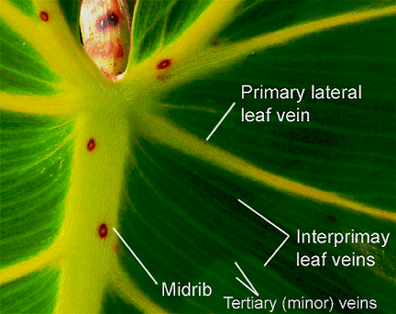 The
midrib as well as basal ribs of Philodendron cordatum possess nectaries that appear as purple/reddish splotches having the color of reddish wine.
In botany this coloration is known as vinaceous (as in the color
of purple grapes) and these
nectaries sometimes exude a sweet sugary extra-floral liquid. Although
the purple splotches can be observed on other parts of the plant
the color alone does not always indicate a nectary is involved.
The
midrib as well as basal ribs of Philodendron cordatum possess nectaries that appear as purple/reddish splotches having the color of reddish wine.
In botany this coloration is known as vinaceous (as in the color
of purple grapes) and these
nectaries sometimes exude a sweet sugary extra-floral liquid. Although
the purple splotches can be observed on other parts of the plant
the color alone does not always indicate a nectary is involved.
Nectar is often produced as a part of pollination but plant
structures that produce nectar for reasons other than attracting
a pollinating insect are known "extra-floral".
These extra-floral nectaries have been observed in at least 2000
species in as many as 64 plant families and are not uncommon in
Araceae. The nectaries can be found on portions of the plant that are
not associated with flowers or reproduction.
Flowers
commonly produce nectar as a
reproductive attractant to cause a pollinator to visit.
The accepted theory for non-reproductive
nectaries includes assisting the plant to maintain a balance
between the water and sugars inside the xylem
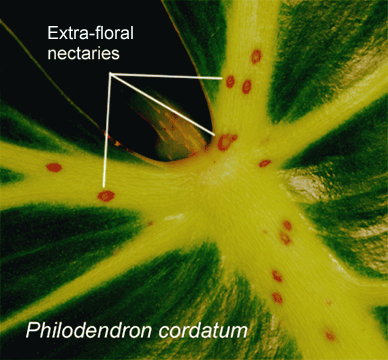 and possibly as a
defensive mechanism. The xylem is a tissue inside the stem
and petiole that conducts water along with sugars and mineral
salts from the roots to all parts of the plant.
and possibly as a
defensive mechanism. The xylem is a tissue inside the stem
and petiole that conducts water along with sugars and mineral
salts from the roots to all parts of the plant.
Extra-floral nectaries often attract
ants and the ants in turn appear to protect vulnerable leaves as well as
tempting plant parts from animals that graze. Many plants
including Philodendron species are known as myrmecophytes or "ant plants".
A myrmecophyte (myr-MECO-fit) is a plant that lives in association with a
colony of ants and possesses specialized organs to entice the ants to build a colony
around their stems (base of the plant). The plant specimen
then obtains nutrients from the nest as well as aeration of the
soil which allows the roots to grow more freely.
The aggressive nature of the ants towards any intruder appears
to protect the plant from other animals or insects who would eat
its parts. The subject of non-reproductive sugars
used as an insect attractant is complex and the relationships
between individual plant species and a variety of insects is not well understood.
The posterior or forelobes contain three to six basal ribs per side. The major veins are flat to only slightly raised and are paler in color on the upper surface. The same veins are convex (raised) on the lower or abaxial surface. The minor veins also visible.
Although
commonly called a "stem" the stalks that support the leaves are
known as petioles. The petiole connects the lamina of the leaf
blade to the stem at the petiole's base. Petioles grow from a bud on the stem and transfer water along with
nutrients to the leaves via a unique form of hydraulic pressure.
Rather than being pushed upwards the water is drawn
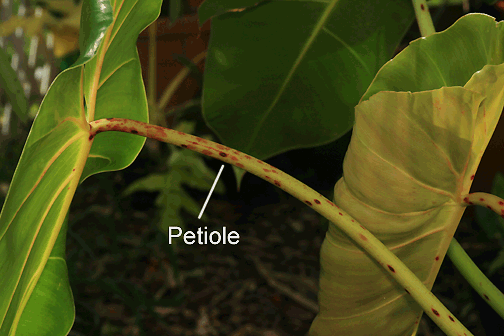 to the blade
by evaporation into the atmosphere though the upper blade
surface. The leaf blades absorb carbon
dioxide in the air and convert it into oxygen for all living organisms to breathe.
to the blade
by evaporation into the atmosphere though the upper blade
surface. The leaf blades absorb carbon
dioxide in the air and convert it into oxygen for all living organisms to breathe.
The
petioles are marked with purple blotches as is the midrib
and other portions of any mature specimen.
The petioles of Philodendron cordatum are weakly
flattened as well as slightly spongy to the touch and typically
measure between 55 to 61 cm (21.5 to 24 inches) on an adult specimen. If
examined closely a slight striation can be observed (photo,
right, below).
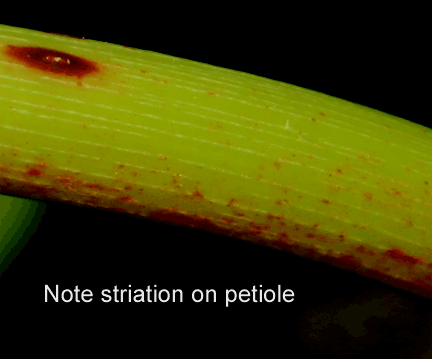 Striation is simply lines running along the axis of the petiole.
Striation is simply lines running along the axis of the petiole.
The cataphylls of Philodendron cordatum are double keeled (two ribbed) as well as a medium green in color. A cataphyll protects the newly emerging leaves as they form and are a bract-like modified leaves that surround any new blade as it first emerges from the bud. A double ribbed cataphyll is known as a prophyll and is a specially modified cataphyll with two ribs or "keels" running along the posterior surface. The cataphylls of P. cordatum are deciduous and fall from the plant once the blade develops. The cataphyll/prophyll of a mature specimen measures approximately 29 to 40 cm (11.4 to 15.75) and is narrowly triangular in shape. As the cataphyll matures it changes from green to yellowish-green before finally turning rusty red. The cataphyll is also covered with vinaceous extra-floral nectaries.
The stem of any
Philodendron is the base or central axis of the plant and is the plant's
main support. Petioles, buds, cataphylls, roots and the
peduncles which support the inflorescences of the specimen grow
from the stem. The stem
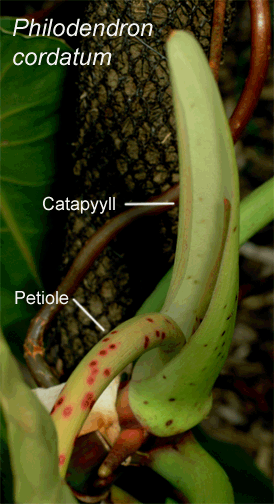 collects and stores
water collected by the roots
which grow from the
nodes at regular
intervals along the stem's length. The stem
segments which separate the nodes
are known as the internodes. Depending on the age of the
specimen the internodes are typically 6 to 8 cm (2.3 to 3
inches) long but may be shorter in young plants. The
internodes and are light brown in color. The stem of P. cordatum is green becoming grayish
as the plant matures.
collects and stores
water collected by the roots
which grow from the
nodes at regular
intervals along the stem's length. The stem
segments which separate the nodes
are known as the internodes. Depending on the age of the
specimen the internodes are typically 6 to 8 cm (2.3 to 3
inches) long but may be shorter in young plants. The
internodes and are light brown in color. The stem of P. cordatum is green becoming grayish
as the plant matures.
Philodendron species are members of the larger
plant family Araceae (uh-RAY-see ee) commonly known as aroids. An aroid is a plant
that reproduces via the production of an inflorescence known as a spathe and spadix.
Although many growers believe the spathe is a
"flower" the spathe is simply a specially modified
leaf whose purpose is to protect the spadix at its center.
The
spathe does not qualify as a flower since it possesses no sexual
parts. All flowers have pistils, stigmas ,ovaries, ovules,
stamens and anthers. Without those sexual parts a flower
has no way to be fertilized or reproduce. A spathe
possesses none of these parts but all can be observed on the
spadix at its center.
The spadix appears as a spike on a thickened fleshy axis which
does in fact
produce tiny flowers.
When ready to reproduce the spadix of a Philodendron produces male,
female and sterile flowers which are cleverly
divided by
Mother nature into separated zones in order to prevent self
pollination. The female flowers are hidden inside a
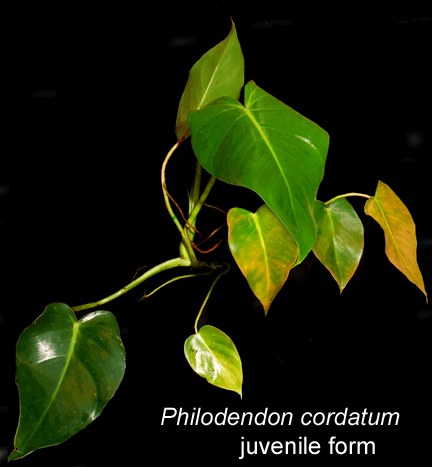 region at the bottom of the spathe known as the "floral
chamber" with the sterile male flowers secreted just
above. The fertile male flowers which produce pollen are
in another region which is exposed on the visible
portion of the spadix well above the floral chamber. The purpose of the sterile
flowers is to produce a perfume-like substance known as a pheromone
which attracts the appropriate pollinating insects but it also serves
as a source of protein for the visiting insect pollinators by producing
lipids.
region at the bottom of the spathe known as the "floral
chamber" with the sterile male flowers secreted just
above. The fertile male flowers which produce pollen are
in another region which is exposed on the visible
portion of the spadix well above the floral chamber. The purpose of the sterile
flowers is to produce a perfume-like substance known as a pheromone
which attracts the appropriate pollinating insects but it also serves
as a source of protein for the visiting insect pollinators by producing
lipids.
The sterile male flowers begin to entice pollinators which are normally small beetles from the genus Cyclocephala by sending out their pheromones on the breeze which floats through the forest. Those beetles gather pollen from another member of the same Philodendron genus and bring it to the female flowers while being enticed to fly to the source of warmth and food in the coolness of the rain forest evening. The beetles can "see" the inflorescence since it produces both a scent and a "glow" in the form of infrared heat which is suspected to be visible to a special receptor on the end of their antennae.
Philodendron
species produce their female flowers on the first evening of anthesis
and they are no longer receptive by the time the male flowers begin to
produce pollen on the second (possibly the third) evening. This is
another of nature's ingenious ways to keep her species pure. If
the female flowers are pollinated with pollen of another plant of the
same species which is already at male anthesis and are carried by an
appropriate beetle from the second
specimen
they may in time produce berries containing seeds.
No photo of the inflorescence or a scientific record of the color of the
berries produced by Philodendron cordatum can be located.
If you are interested in a more detailed account of how aroids reproduce
please visit this link:
Natural and artificial pollination in aroids.
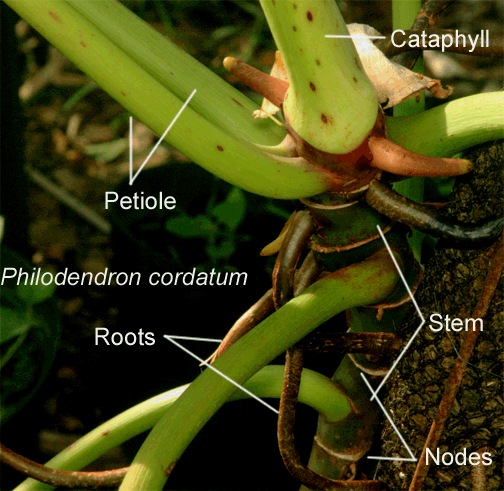 Philodendron
cordatum produces one to three inflorescences per floral sympodium
(axil).
The inflorescences are supported by a stalk known as a peduncle
which can measure 3 to 9 cm (1.2 to 3.55 inches) in length. The spathes
typically measure 17 to 21 cm (6.7 to 8.25 inches) long and are slightly
constricted at the center. The outer portion of the spathe blade is green
to a greenish cream color and also exhibits vinaceous grooves
once immature. The spathe becomes cream colored on both
the inner and outer surfaces once the inflorescence approaches anthesis
finally turning
pinkish red to red on the outer surface once anthesis is complete.
The spadices typically measure 15 to18 cm in length.
Philodendron
cordatum produces one to three inflorescences per floral sympodium
(axil).
The inflorescences are supported by a stalk known as a peduncle
which can measure 3 to 9 cm (1.2 to 3.55 inches) in length. The spathes
typically measure 17 to 21 cm (6.7 to 8.25 inches) long and are slightly
constricted at the center. The outer portion of the spathe blade is green
to a greenish cream color and also exhibits vinaceous grooves
once immature. The spathe becomes cream colored on both
the inner and outer surfaces once the inflorescence approaches anthesis
finally turning
pinkish red to red on the outer surface once anthesis is complete.
The spadices typically measure 15 to18 cm in length.
Philodendron
species are
known to be highly variable and not every leaf of every specimen
will always appear the same. As can be seen in the photos on
this page, Philodendron species go through morphogenesis
(ontogeny) as they mature. This link explains in
non-technical language natural variation and
morphogenesis within aroid and other species.
Click
here.
My thanks to Leland Miyano
for his expert input as well as John Criswick and Phil Nelson for the use of
their photos. Phil Nelson is associated with the Marie Selby Botanical Gardens in Sarasota, FL.
The scientific data for this
article was extracted from the published field notes of Dr.
Thomas B. Croat Ph.D., P.A. Schulze Curator of Botany at the Missouri Botanical Garden in St. Louis, MO. as
well as from the Royal Botanic Kew's CATE Araceae. You can
view
the scientific information for Philodendron cordatum
Kunth on TROPICOS (a service of the Missouri Botanical Garden)
including enlargeable photos here:
http://www.tropicos.org/Name/2103189
Cate Araceae can be found here:
http://www.cate-araceae.org/index.do;jsessionid=96982249A0181F1EB1E74E6CEB9841D4
Philodendron cordatum does not match the scientific description of either Philodendron scandens, Philodendron oxycardium nor the accepted species name Philodendron hederaceum. You can read our synopsis for Philodendron hederaceum (Philodendron scandens, Philodendron oxycardium) here.
Looking for a specimen? Contact
http:///

http://www.briansbotanicals.net/index2.html
or
Want to learn more
about aroids?
Join the
International Aroid Society:
http://www.exoticrainforest.com/Join%20IAS.html